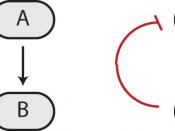HOMEOSTASIS
According to totora .......... Homeostasis can be defined as " the condition in which the body's internal environment remains constant, within physiological limits". Homeostasis is a dynamic condition as the body's equilibrium point can change over a narrow range that is compatible with maintaining life. E.g., the level of glucose in the blood does not normally fall below 70mg of glucose per 100ml of blood.
Each body structure helps to contribute to keep the internal environment within its normal limits. For example, if the level of blood glucose within the drops then the body compensates it by using fats stores as a reserve supply of glucose
Body fluids
An important aspect of homeostasis is maintaining the volume and composition of body fluid. The fluid within cells is called intracellular fluid (ICF). The fluid outside the body cell is called extracelluar fluid (ECF). Dissolved in the ICF and ECF are substances needed to maintain life such as O2, nutrients, proteins and electrally charged ions.
Bernard predicted - the proper functioning of the body depends on precise regulation of the composition of the surrounding fluids of cells, known as interstitial fluid (internal environment). The composition of interstitial fluid changes as substances move in and out of the cell. For example, there is an exchange of materials across the capillary walls. This exchange of movement in both directions provides the capillary with much needed ions such as glucose and O2 to tissue cells and removes wastes such as CO2 from interstitial fluid.
Control of homeostasis
Homeostasis in the body is continually being disrupted. The disruption may come from the external environment such as the lack of O2 or the lack of heat. In most cases the disruption of homeostasis is mild and temporary and the body cells can restore the internal environment.


